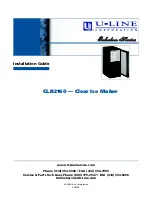
22
•
When removing the plug never pull on
the cable.
•
Unplug the appliance before cleaning or
maintenance.
•
In the event of fault or malfunction
where the appliance is not to be used,
turn off the appliance and do not
attempt to repair. If a repair is required,
contact a Technical Assistance Service
authorised by the manufacturer and
request the use of original spare parts.
•
If the cable for this appliance is
damaged, contact an authorised
Technical Assistance Service for it to be
replaced.
•
Do not leave the appliance exposed to
the elements (rain, sun, ice, etc.).
•
Do not use or let any part of the
appliance come into contact or near hot
surfaces (kitchen gas or electric hobs or
ovens).
•
Do not use detergents or abrasive
sponges to clean the appliance.
•
Do not touch the hot surfaces. Use the
handles.
•
Do not let the cable come into contact
with the hot parts of the appliance.
•
Use gloves to protect from burning.
•
Leave oven to cool before cleaning.
•
Do no immerse appliance in water or
any other liquid.
•
To add ingredients always remove the
bread mould from the baking chamber.
•
Do not use the Breadmaker when
empty, as this could cause it serious
damage.
•
Do not use the baking chamber for
storage purposes.
•
Do not cover the steam vents and
ensure that there is sufficient ventilation
around the Breadmaker while running.
Place the appliance at least 5 cms.
from the wall.
4. PREPARATION
1.
Before using the machine for the first
time carefully clean all the parts (see
"Cleaning" section).
2.
Place the breadmaker on a flat stable
surface.
5. MEASURING INGREDIENTS
It is essential to carry out the preparation
very carefully to obtain the best results.
Allow sufficient time to carefully read
the recipes and measure and weigh the
ingredients exactly. The order and the
measurements for the ingredients should
be used as indicated in the recipes to
maintain the best results, after the machine
has been used a few times, the ingredients
can be altered to suit your taste.
•
Always measure liquid ingredients
(e.g. water or milk) in the transparent
measuring glass
(19)
which has
measuring marks. The level of the
liquids must coincide with the marks on
the measuring glass, neither above nor
below
(Fig. D)
.
•
Use an accurate kitchen scale or double
measuring spoon
(20)
to measure
ingredients such as flour, yeast, sugar
etc.
(Fig. E & F)
. For the recipes, the
smallest part of the spoon corresponds
to a teaspoon and the large part to a
tablespoon.
Measure and pour the liquid ingredients
into the bread mould
(Fig. G)
. Measure and
mix all the dry ingredients before adding
them to the liquid. Add the mix to the liquid
(Fig. H)
.
Tip:
add the yeast at the end, so that the
dough rises in the best conditions. Make a
small hole in the middle of the mix and add
the yeast.
3.
Open the cover, remove the bread
mould and fit the kneading blade on the
mould driving shaft
(Fig. B)
.
4.
Choose the recipe for the type of bread
required.
5.
Measure and pour the ingredients as in
the following section.
6.
Place the bread mould into the baking
pan and push down to ensure that the
mould is well fixed into position
(Fig. C)
.
7.
Lower the handle and close the cover.
8.
Plug in the machine. A beep sound will
be heard and the LCD screen
(9)
will
flash “0:00”.
Содержание MAP-5511
Страница 42: ......
















































